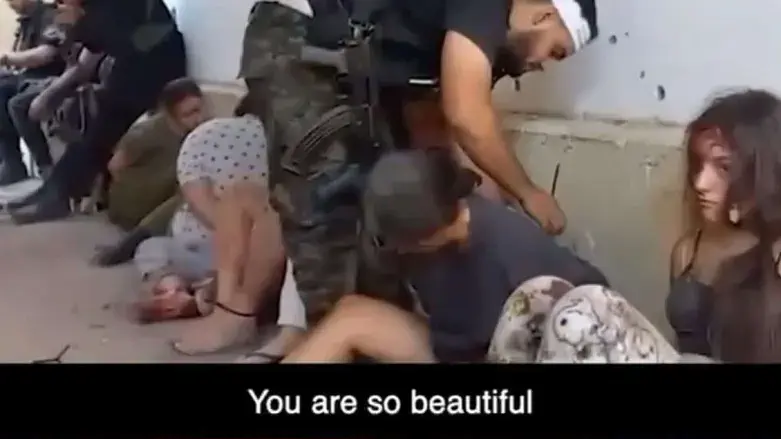
There is only one thing I dread: not to be worthy of my sufferings.
— Fyodor Dostoyevsky
In the days immediately after the October 7 massacre, I wanted to know everything: the details, the videos, the stories—they seared my eyes and my heart, but I couldn’t look away. I wanted to feel the pain, the terror, the anger, the sorrow. I wanted to cry and scream and feel all the feelings with my brothers and sisters.
But it became too much. It's not easy to read an account from the Nova festival and then turn around to give my kids breakfast. To see images of terror and destruction and then go meet a friend for lunch. To go from tears streaming down my face to a carefree afternoon in the park.
So I stopped looking.
I needed to function as a wife, a mother, and a human being, so I turned away. After a while, it wasn’t just that I stopped seeking out news and stories about that terrible day—I actively avoided them. I couldn’t bear to open Instagram and see Ariel Bibas’ face, breaking my heart all over again. I didn’t want to hear another shockingly brutal account of that day. I didn’t want to watch another video of the hostages, bloody, broken, and bruised. I wanted to escape it, to live in a world where stepping outside wasn’t a reminder of the dark shadows lurking around every corner.
Was I being selfish? A coward? How could I turn away from the suffering of my People to protect myself? Didn’t I have an obligation to share in the tragedy, to look and to bear witness?
As Tisha B'Av, the saddest day in the Jewish calendar, has come and gone, these questions weigh heavily on me. This day, the 9 of Av, marks the culmination of the Three Weeks, a period of mourning for the destruction of the Holy Temple in Jerusalem. Over time, Tisha B'Av has become a day to mourn and remember all the communal tragedies that the Jewish People have endured throughout history. We fast, mourn and observe the customs of mourning as we reflect on our collective suffering.

There is a vast difference between personal grief and collective grief. Personal grief isn't something we can control; it comes in waves, crashing over us when we least expect it. Sometimes it ebbs, sometimes it flows, but it is always present, lingering at the edges of our consciousness. Sharing in someone's personal grief can be a profound comfort to the sufferer. Simply saying, "I’m here with you," can make a mourner feel less alone in their pain.
But does sharing in collective grief really help anyone? What is the purpose of mourning as a community, as a group? If those directly affected aren't there, is there still value in choosing to engage with the collective's pain?
There’s a quote from Tuesday’s with Morrie by Mitch Albom that speaks to this:
The truth is, once you learn how to die, you learn how to live.
It sounds a bit morbid, I know, but it’s profoundly true. If we don’t engage with death, with suffering, with pain, we can’t truly engage with life.
Collective suffering calls on us to do more than feel empathy—it invites us to participate in a communal search for meaning. This isn’t about suggesting that the suffering of others exists to teach us something; I don’t want to diminish anyone’s pain by turning it into a tidy “life lesson.” But it’s about acknowledging that when we confront suffering together, we find a kind of solidarity and understanding that helps us bear the weight of our own pain.
Paul Kalanithi, the author of When Breath Becomes Air, was a 36-year-old neurosurgeon when he was diagnosed with terminal cancer. He came to realize that “Life wasn’t about avoiding suffering.”
Personal tragedy is thrust upon us, but communal tragedy offers us a choice. We can look away if we wish. But to experience hardship, pain, and suffering as a community and not engage with it is a missed opportunity. Life isn’t about avoiding pain; it’s about enduring it and transforming it and then returning to life. When we confront suffering together, it doesn’t remain a static, corrosive force eating away at our collective consciousness. Instead, it becomes a means to strengthen the bonds that make us human and help one another find meaning even in the darkest times.
As Susan Cain writes in Bittersweet:
If we could honor sadness a little more, maybe we could see it—rather than enforced smiles and righteous outrage—as the bridge we need to connect with each other. We could remember that no matter how distasteful we might find someone’s opinions, no matter how radiant or fierce someone may appear, they have suffered, or they will.
Honoring and remembering our collective sadness brings us together like nothing else, stripping away the superficialities that blind and separate us.
But we can’t live in this place of sorrow always. We have to function, eat, sleep, and yes, move on—to an extent. We can’t stay in mourning forever. At some point, we must look away.
But Tisha B’Av reminds us that while it’s important to move past sadness and tragedy, we must not forget it completely. We must set aside time to remember, to turn toward the anguish and say, “I’m here. I see you.” And in this way, by acknowledging the pain without being consumed by it, we honor the past, connect with each other in the present, and find the strength to build a future filled with hope.